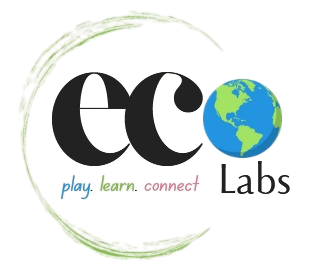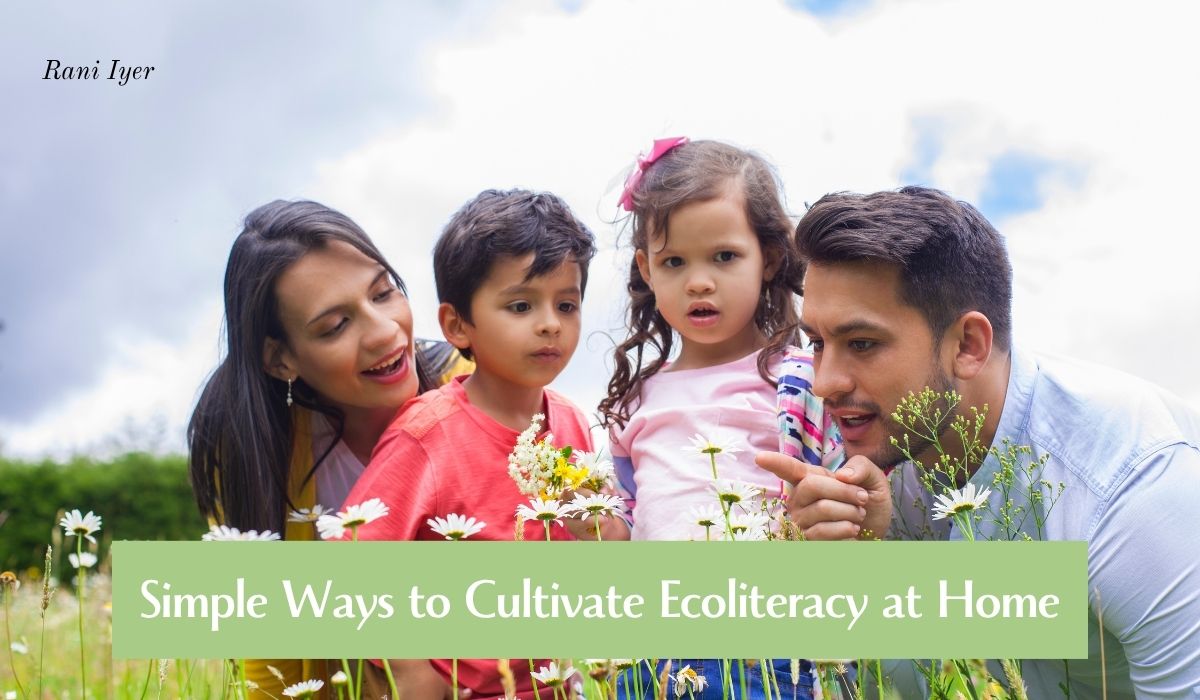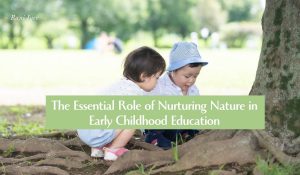In an era where environmental awareness is more critical than ever, cultivating ecoliteracy at home is not just beneficial—it’s essential. Empowering your family with the knowledge and skills to understand the interconnectedness of our ecosystems lays the foundation for sustainable living. Imagine transforming your household into a hub of green practices, where each member contributes to protecting our planet. From practical everyday choices to engaging activities that spark curiosity, nurturing ecoliteracy can be a rewarding journey for both kids and adults. This article presents simple ways to integrate eco-friendly habits into your daily routine, encouraging discussions about sustainability while fostering a deeper connection to nature. By embracing these steps, you’ll not only enhance your family’s understanding of environmental issues but also inspire a sense of responsibility and action towards a healthier Earth for future generations. Let’s embark on this exciting adventure towards a sustainable future together!
Understanding Ecoliteracy: What It Is and Why It Matters
Ecoliteracy, a term coined by the Center for Ecoliteracy, refers to the understanding of the natural systems that make life on Earth possible. It’s the knowledge of ecological principles and the ability to apply this understanding to create sustainable human communities. At its core, ecoliteracy emphasizes the intricate interconnectedness of all living organisms and the environment. By grasping these connections, we can make informed decisions that contribute to a healthier planet. This form of literacy goes beyond traditional education, integrating emotional, social, and spiritual dimensions to foster a holistic approach to environmental stewardship.
In today’s world, where environmental challenges such as climate change, biodiversity loss, and pollution are prevalent, ecoliteracy is more critical than ever. It equips individuals with the skills to recognize the impact of human activities on the environment and to take meaningful action. Ecoliteracy cultivates a sense of responsibility towards the Earth, encouraging sustainable practices that reduce our ecological footprint. It empowers people to contribute to the preservation and restoration of natural systems, ensuring the well-being of future generations.
For families, cultivating ecoliteracy at home can be a transformative experience. It offers an opportunity to bond over shared values and activities, fostering a sense of unity and purpose. By instilling ecoliteracy in children from a young age, parents can nurture a generation of environmentally conscious individuals who are equipped to tackle the challenges of tomorrow. This foundation of knowledge and awareness can lead to a lifetime of sustainable living, where each family member plays a role in protecting our planet.
The Importance of Ecoliteracy for Families
Ecoliteracy is not just an individual pursuit; it has significant implications for families as well. When families embrace ecoliteracy, they create a supportive environment where sustainable practices become a part of everyday life. This collective effort can lead to meaningful changes in behavior, from reducing waste to conserving energy and water. By working together towards common environmental goals, families can strengthen their bonds and create lasting memories.
One of the key benefits of ecoliteracy for families is the development of a shared understanding of environmental issues. When parents and children learn about the impact of their actions on the environment, they can engage in meaningful discussions and make informed choices together. This collaborative approach fosters a sense of agency and empowerment, as each family member feels that their contributions matter. It also encourages critical thinking and problem-solving skills, which are essential for addressing complex environmental challenges.
Moreover, cultivating ecoliteracy at home can inspire a sense of wonder and appreciation for the natural world. By exploring nature together, families can discover the beauty and intricacy of ecosystems, sparking curiosity and a desire to protect them. This connection to nature can have profound effects on well-being, promoting physical health, mental clarity, and emotional resilience. As families deepen their relationship with the environment, they can experience a greater sense of purpose and fulfillment.
Creating a Sustainable Home Environment
Creating a sustainable home environment is a foundational step in cultivating ecoliteracy. It involves making conscious choices that minimize environmental impact while promoting health and well-being. One of the most effective ways to start is by conducting a home energy audit. This assessment helps identify areas where energy is being wasted and provides actionable recommendations for improvement. Simple changes, such as switching to energy-efficient appliances, using LED light bulbs, and sealing drafts, can significantly reduce energy consumption and lower utility bills.
Water conservation is another critical aspect of a sustainable home. Implementing water-saving measures, such as installing low-flow fixtures, fixing leaks, and using rain barrels, can help preserve this precious resource. Encouraging shorter showers and mindful water use in daily activities can also make a difference. By being mindful of water usage, families can contribute to the conservation of freshwater ecosystems and reduce their environmental footprint.
In addition to energy and water conservation, creating a sustainable home involves thoughtful choices in areas such as waste management, transportation, and household products. Adopting a zero-waste mindset can reduce the amount of waste sent to landfills. This can be achieved through practices such as composting organic waste, recycling, and reusing items. Opting for non-toxic, eco-friendly cleaning products and materials can also promote a healthier living environment. By making these changes, families can create a home that aligns with their values and supports a sustainable future.
Engaging Kids with Nature: Outdoor Activities
Engaging children with nature is a powerful way to cultivate ecoliteracy and foster a love for the environment. Outdoor activities provide hands-on learning experiences that can deepen children’s understanding of ecological principles. One of the simplest and most enjoyable ways to connect kids with nature is through regular family outings to parks, nature reserves, and forests. These excursions offer opportunities to observe wildlife, explore diverse ecosystems, and learn about the interconnections within nature.
Gardening is another fantastic activity that can teach children about the cycles of life and the importance of nurturing the environment. By growing their own fruits, vegetables, and flowers, kids can learn about plant biology, soil health, and sustainable agriculture practices. Gardening also provides a sense of accomplishment and responsibility, as children see the results of their efforts in the form of thriving plants. It’s a rewarding way to instill a love for nature and an understanding of where food comes from.
Nature-based crafts and projects can also spark children’s creativity and curiosity. Activities such as building birdhouses, creating leaf rubbings, or making nature journals allow kids to engage with their surroundings in meaningful ways. These projects can be both educational and fun, providing opportunities for children to develop new skills and express their creativity. By incorporating nature into play and learning, families can foster a deeper connection to the environment and inspire a lifelong commitment to sustainability.
Incorporating Eco-Friendly Practices in Daily Life
Incorporating eco-friendly practices into daily life is essential for cultivating ecoliteracy and promoting sustainable living. One of the most impactful changes families can make is reducing their reliance on single-use plastics. Simple swaps, such as using reusable bags, bottles, and containers, can significantly decrease plastic waste. Encouraging the use of cloth napkins, beeswax wraps, and stainless steel straws are other practical steps that can make a big difference over time.
Transportation choices also play a crucial role in reducing environmental impact. Families can opt for walking, biking, or using public transportation whenever possible, instead of relying on cars for short trips. Carpooling and planning routes efficiently can help reduce fuel consumption and greenhouse gas emissions. Additionally, considering the purchase of energy-efficient vehicles or electric cars can contribute to a more sustainable lifestyle.
Mindful consumption is another key aspect of eco-friendly living. By making informed choices about the products they buy, families can support companies that prioritize sustainability and ethical practices. This includes selecting organic and fair-trade products, choosing items with minimal packaging, and avoiding products that contribute to deforestation or pollution. Embracing a minimalist mindset and focusing on quality over quantity can also reduce waste and promote a more sustainable lifestyle.
Educational Resources for Ecoliteracy
Access to quality educational resources is vital for cultivating ecoliteracy at home. There are numerous books, documentaries, and online platforms that provide valuable information on environmental topics. Reading books about nature, wildlife, and sustainability can spark curiosity and provide a solid foundation of knowledge. Some popular titles include “The Lorax” by Dr. Seuss for younger children, and “Silent Spring” by Rachel Carson for older readers. These books can inspire meaningful conversations about environmental issues and the importance of conservation.
Documentaries and films are another powerful way to engage with environmental topics. Movies like “Our Planet,” “The True Cost,” and “A Plastic Ocean” offer compelling insights into the challenges facing our planet and the efforts being made to address them. Watching these films as a family can prompt discussions about the impact of human activities on the environment and the steps that can be taken to mitigate these effects. It can also motivate viewers to take action in their own lives.
Online resources, such as educational websites and interactive apps, provide a wealth of information and activities that can enhance ecoliteracy. Websites like National Geographic Kids, Eco-Schools, and the World Wildlife Fund offer educational materials, games, and activities designed to teach children about the environment in an engaging and interactive way. These resources can supplement traditional learning and provide opportunities for families to explore environmental topics together.
Encouraging Sustainable Food Choices
Sustainable food choices are a cornerstone of ecoliteracy and have a significant impact on the environment. By making mindful decisions about what they eat, families can reduce their carbon footprint and support sustainable agriculture practices. One of the most effective ways to encourage sustainable eating is by incorporating more plant-based meals into the diet. Plant-based foods typically have a lower environmental impact compared to animal-based products, as they require fewer resources such as water, land, and energy to produce.
Supporting local and organic farmers is another way to promote sustainability through food choices. Local produce often has a smaller carbon footprint due to reduced transportation distances, and organic farming practices prioritize soil health, biodiversity, and the avoidance of harmful pesticides and fertilizers. Shopping at farmers’ markets, joining a community-supported agriculture (CSA) program, or growing your own food are all excellent ways to access fresh, local, and sustainably produced food.
Reducing food waste is also a critical component of sustainable eating. Families can minimize waste by planning meals, using leftovers creatively, and composting food scraps. Understanding portion sizes, storing food properly, and being mindful of expiration dates can help reduce the amount of food that goes to waste. By making these changes, families can contribute to a more sustainable food system and reduce their overall environmental impact.
Reducing Waste: Practical Tips for the Family
Reducing waste is a fundamental aspect of sustainable living and an essential practice for cultivating ecoliteracy. One of the most effective ways to reduce waste is by embracing the principles of “reduce, reuse, recycle.” This approach encourages families to minimize their consumption, find new uses for items, and recycle materials whenever possible. By adopting these principles, families can significantly decrease the amount of waste they generate and contribute to a circular economy.
Reducing waste starts with mindful consumption. Families can prioritize quality over quantity, choosing durable and long-lasting products that can be repaired or reused. Avoiding single-use items and opting for reusable alternatives, such as cloth bags, metal water bottles, and glass containers, can make a significant difference. Additionally, buying in bulk and selecting products with minimal packaging can help reduce waste and support a more sustainable lifestyle.
Recycling is another crucial component of waste reduction. Families can set up a comprehensive recycling system at home, making it easy to sort and recycle materials such as paper, cardboard, glass, and metals. Educating family members about what can and cannot be recycled is important for ensuring that recyclable materials are properly processed. Composting organic waste, such as food scraps and yard trimmings, is another effective way to reduce waste and create nutrient-rich soil for gardening.
Building a Community of Ecoliteracy
Cultivating ecoliteracy at home is a powerful step, but extending these efforts to the broader community can amplify the impact. Building a community of ecoliteracy involves sharing knowledge, resources, and support with neighbors, friends, and local organizations. This collective effort can lead to meaningful change and create a culture of sustainability within the community. Hosting workshops, organizing clean-up events, and participating in community gardening projects are all effective ways to promote ecoliteracy and environmental stewardship.
Schools and educational institutions play a crucial role in fostering ecoliteracy within the community. Families can collaborate with schools to support environmental education programs, advocate for sustainable practices, and participate in school-related green initiatives. By working together, parents, teachers, and students can create a learning environment that prioritizes sustainability and equips the next generation with the knowledge and skills to address environmental challenges.
Local government and community organizations also play a vital role in promoting ecoliteracy. Families can engage with these entities to support policies and initiatives that prioritize environmental sustainability. This can include advocating for clean energy, supporting public transportation, and participating in local conservation efforts. By being active and involved in the community, families can make a significant impact and contribute to a more sustainable future.
Embracing Ecoliteracy for a Greener Future
Cultivating ecoliteracy at home is a rewarding journey that empowers families to live more sustainably and make a positive impact on the environment. By understanding the interconnectedness of natural systems and making informed choices, families can create a home environment that reflects their commitment to sustainability. Engaging with nature, incorporating eco-friendly practices, and accessing educational resources all play a crucial role in fostering ecoliteracy.
Encouraging sustainable food choices, reducing waste, and building a community of ecoliteracy further amplify these efforts, creating a ripple effect that extends beyond the household. As families embrace ecoliteracy, they can inspire others to do the same, contributing to a collective movement towards a greener future. This journey not only enhances understanding of environmental issues but also fosters a sense of responsibility and action towards protecting our planet.
Ultimately, the cultivation of ecoliteracy at home is about nurturing a deep connection to nature and instilling values that prioritize the well-being of the Earth. It’s about empowering each family member to make a difference and working together towards a sustainable future. By embracing these 10 simple ways to cultivate ecoliteracy, families can embark on an exciting adventure that leads to a healthier, more sustainable world for generations to come.


